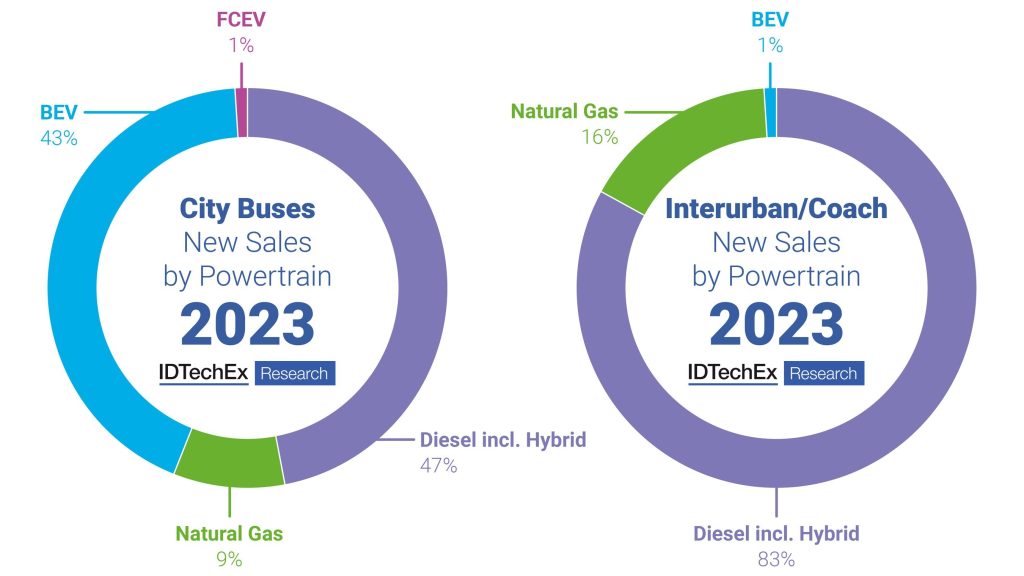EVs (electric vehicles) offer huge opportunities—at least that’s the hope—not just for consumers, but also for businesses. From airplanes to mail carriers to buses, EVs (electric vehicles) are coming to all aspects of our cities, although some areas are moving a little bit faster than others.
IDTechEx suggests the electric buses market is booming with sales growing in Europe, America, India, and other key regions. In fact, research shows more than half of all city bus sales in Europe in 2023 were electric (battery and fuel cell) and that some regions are ahead of the European Union’s target for 100% of new city buses to zero emissions by 2035. But here’s the rub, in the coach segment, only around 1% of sales were electric across the same period. So, what gives?

What’s Driving EVs?
Certainly, there are some markets that are better suited for electric vehicles, and it seems city buses are proving to be a good candidate for electrification, according to IDTechEx.
Let’s delve into this from a bit of a historical and geographical context. Buses were one of the first transportation sectors to demonstrate they could be completely electrified. In China, for example, sales began at pace in the early 2010s and reached a peak in 2016 when almost 140,000 electric buses were sold in a single year. While the sales figures have since declined and then plateaued, the overall bus fleet is now more than 77% electric.
As we consider EVs in our own cities, we also must consider the value they bring and the hurdles we face. First the benefits, there are the sustainability and environmental aspects to consider and then of course long-term cost savings.
But the hurdles are huge. For instance, let’s consider the biggest elephant in the room: the fact that they need to be charged. For some public transit this becomes a significant challenge and perhaps one of the biggest concerns.
Incidentally, coach journeys are typically much longer and travel interurban, intercity, and even international routes. As such, the limited range is a much greater challenge than that of a city bus, which may have a much lower daily required mileage. City buses often follow a predetermined route with set schedules. Here range anxiety becomes less of a challenge. Buses are also often parked overnight in depts, presenting the perfect place and opportunity to charge.
Of course, charging and infrastructure are only a few hurdles. Funding, training, and speed to market are just a handful of reasons EVs are slow to market.
What’s Next?
I have spent quite a bit of time looking at the electric bus situation here in South Carolina, having explored school districts that have added electric buses to their fleet and having spent time working closely with Proterra, which is a battery company with a plant here in South Carolina and is now in the process of reorganization after filing for Chapter 11 last year.
I wonder if there is a way technology, specifically AI (artificial intelligence), can help here—and it certainly can if we look at this from two different angles.
Undoubtedly, we can talk about the value that AI will add to the manufacturing line, helping to speed up processes through things such as predictive maintenance, where it ultimately minimizes downtime. AI can help us better manage inventory and the supply chain by predicting demand and preventing bottlenecks. AI can help speed product development and bring new systems to market faster.
But there is the other side to this coin too. AI can help with the EVs themselves. It can analyze battery power, helping to optimize vehicle efficiency, ultimately keeping an eye on metrics such as emissions and carbon. As with any vehicle, AI can help with predictive maintenance, enabling repair shops to identify problems more quickly and prevent future breakdowns. And, of course, these are only a few examples. The sky is the limit to advance the opportunities we have with EVs in our cities.
However, the challenge is AI can’t work in a vacuum. It must work in tandem with people and process. The bottomline is the electric market is growing quickly and while there is certainly an opportunity for cities to gain efficiencies, we must proceed carefully and with caution. We must ensure we have the right people, processes, and technologies in place to ensure success for the long haul.
Want to tweet about this article? Use hashtags #IoT #sustainability #AI #5G #cloud #edge #futureofwork #digitaltransformation #green #ecosystem #environmental #circularworld #EV #electricvehicle


